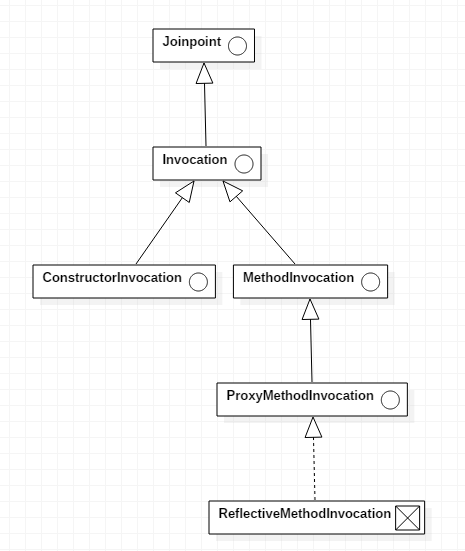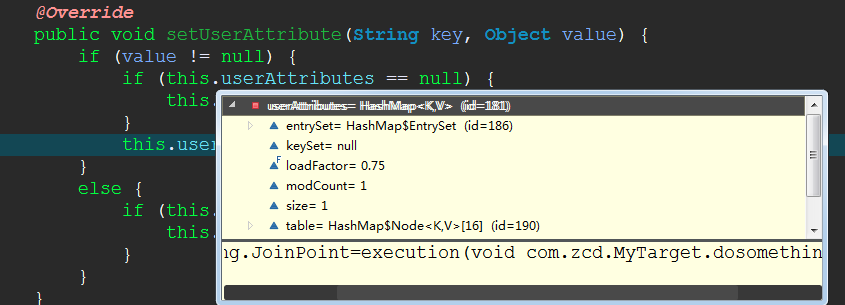Joinpoint继承体系-笔记
Joinpoint继承层次图:

由上图可以知道的所有的接口的实现都在ReflectiveMethodInvocation这个类中。ConstructorInvocation接口只有一个方法,这个方法的实现好像是由ReflectMethodInvocation的getStaticPart()方法来实现的,具体请看源码。
现在把上面的接口和类的源码的看看,顺便做下笔记。
一、Joinpoint
这个接口表示一个一般的运行时连接点。一个运行时连接点是一个事件,这个事件发生在一个静态连接点(也就是在程序中的某一个位置)。例如:
接口的方法:
/**
* Proceed to the next interceptor in the chain.
* <p>The implementation and the semantics of this method depends
* on the actual joinpoint type (see the children interfaces).
* @return see the children interfaces' proceed definition
* @throws Throwable if the joinpoint throws an exception
*/
Object proceed() throws Throwable;
开始拦截器链条中的下一个的拦截器。
/**
* Return the object that holds the current joinpoint's static part.
* <p>For instance, the target object for an invocation.
* @return the object (can be null if the accessible object is static)
*/
Object getThis();
返回目标对象。
/**
* Return the static part of this joinpoint.
* <p>The static part is an accessible object on which a chain of
* interceptors are installed.
*/
AccessibleObject getStaticPart();
返回连接点的静态部分,其实应该就是目标方法吧。(返回连接点的静态部分,静态部分就是的已经安装在拦截器链条上的可以访问的方法对象。)
二、Invocation
这个接口表示程序当中的一个调用。一个调用就是一个连接点而且可以被一个拦截器拦截。
这个接口只有一个方法:
/**
* This interface represents an invocation in the program.
*
* <p>An invocation is a joinpoint and can be intercepted by an
* interceptor.
*
* @author Rod Johnson
*/
public interface Invocation extends Joinpoint { /**
* Get the arguments as an array object.
* It is possible to change element values within this
* array to change the arguments.
* @return the argument of the invocation
*/
Object[] getArguments(); }
方法返回的是目标方法的参数。如果目标方法是无参方法,那么会返回一个Object[] 类型的长度为0的数组。
三、MethodInvocation
/**
* Description of an invocation to a method, given to an interceptor
* upon method-call.
*
* <p>A method invocation is a joinpoint and can be intercepted by a
* method interceptor.
*
* @author Rod Johnson
* @see MethodInterceptor
*/
public interface MethodInvocation extends Invocation { /**
* Get the method being called.
* <p>This method is a frienly implementation of the
* {@link Joinpoint#getStaticPart()} method (same result).
* @return the method being called
*///返回一个已经被调用的方法,其实是目标方法。
Method getMethod(); }
getMethod()方法返回的是目标方法对应的Method对象。
四、ProxyMethodInvocation
这个接口扩展了MethodInvocation接口。
接口的方法:
/**
* Return the proxy that this method invocation was made through.
* @return the original proxy object
*/
Object getProxy();
返回原始的对象,也就是目标对象。
/**
* Create a clone of this object. If cloning is done before {@code proceed()}
* is invoked on this object, {@code proceed()} can be invoked once per clone
* to invoke the joinpoint (and the rest of the advice chain) more than once.
* @return an invocable clone of this invocation.
* {@code proceed()} can be called once per clone.
*/
MethodInvocation invocableClone();
浅复制
/**
* Set the arguments to be used on subsequent invocations in the any advice
* in this chain.
* @param arguments the argument array
*/
void setArguments(Object... arguments);
设置目标方法的参数值。
/**
* Add the specified user attribute with the given value to this invocation.
* <p>Such attributes are not used within the AOP framework itself. They are
* just kept as part of the invocation object, for use in special interceptors.
* @param key the name of the attribute
* @param value the value of the attribute, or {@code null} to reset it
*/
void setUserAttribute(String key, Object value);
设置用户属性

五、ReflectiveMethodInvocation
使用反射类调用目标对象。子类可以覆盖invokeJoinpoint()方法。可以通过使用invocableClone()方法浅克隆一个调用(an invocation)来重复调用proceed()方法。而且还可以使用setUserAttribute(...)方法添加上自定义的属性到这个调用上。
这个类的属性:
protected final Object proxy;//代理对象。
protected final Object target;//目标对象。
protected final Method method;//目标方法对应的Method对象。
protected Object[] arguments;//目标方法参数。
private final Class<?> targetClass;//目标对象的类型
/**
* Lazily initialized map of user-specific attributes for this invocation.
*/
private Map<String, Object> userAttributes;
/**
* List of MethodInterceptor and InterceptorAndDynamicMethodMatcher
* that need dynamic checks.
*/
protected final List<?> interceptorsAndDynamicMethodMatchers;
/**
* Index from 0 of the current interceptor we're invoking.
* -1 until we invoke: then the current interceptor.
*/
private int currentInterceptorIndex = -1;
这个类的方法:
这个类方法也不少,挑重要的讲。
①、构造器。
/**
* Construct a new ReflectiveMethodInvocation with the given arguments.
* @param proxy the proxy object that the invocation was made on
* @param target the target object to invoke
* @param method the method to invoke
* @param arguments the arguments to invoke the method with
* @param targetClass the target class, for MethodMatcher invocations
* @param interceptorsAndDynamicMethodMatchers interceptors that should be applied,
* along with any InterceptorAndDynamicMethodMatchers that need evaluation at runtime.
* MethodMatchers included in this struct must already have been found to have matched
* as far as was possibly statically. Passing an array might be about 10% faster,
* but would complicate the code. And it would work only for static pointcuts.
*/
protected ReflectiveMethodInvocation(
Object proxy, Object target, Method method, Object[] arguments,
Class<?> targetClass, List<Object> interceptorsAndDynamicMethodMatchers) { this.proxy = proxy;
this.target = target;
this.targetClass = targetClass;
this.method = BridgeMethodResolver.findBridgedMethod(method);
this.arguments = AopProxyUtils.adaptArgumentsIfNecessary(method, arguments);
this.interceptorsAndDynamicMethodMatchers = interceptorsAndDynamicMethodMatchers;
}
这个构造器在初始化对象时,设置了代理对象、目标对象、目标对象所属的类Calss对象、目标方法对应的Method对象、目标方法的参数、以及MethodInterceptor和InterceptorAndDynamicMethodMatcher组成的链条。
②、这是方法最重要。不管是通知方法还是目标方法,都是通过的这个方法来调用的。所以,连接点起到了一个调度的作用。
@Override
public Object proceed() throws Throwable {
// We start with an index of -1 and increment early.
//currentInterceptorIndex的值等于拦截器链的长度的时候说明每个拦截器都被调用了。此时可以调用目标方法了。
if (this.currentInterceptorIndex == this.interceptorsAndDynamicMethodMatchers.size() - 1) {
return invokeJoinpoint();//调用目标方法,不知道这里的方法名为什么叫invokeJoinpoint,明明是调用的目标方法嘛,还没参透。
} //currentInterceptorIndex的初始值为-1,所以它是从拦截器链条的第一个拦截器开始调用拦截器的。先++。
Object interceptorOrInterceptionAdvice =
this.interceptorsAndDynamicMethodMatchers.get(++this.currentInterceptorIndex);
if (interceptorOrInterceptionAdvice instanceof InterceptorAndDynamicMethodMatcher) {
// Evaluate dynamic method matcher here: static part will already have
// been evaluated and found to match.
InterceptorAndDynamicMethodMatcher dm =
(InterceptorAndDynamicMethodMatcher) interceptorOrInterceptionAdvice;
if (dm.methodMatcher.matches(this.method, this.targetClass, this.arguments)) {
return dm.interceptor.invoke(this);
}
else {
// Dynamic matching failed.
// Skip this interceptor and invoke the next in the chain.
//跳过当前的拦截器并且调用链条中的下一个拦截器.
return proceed();
}
}
else {
// It's an interceptor, so we just invoke it: The pointcut will have
// been evaluated statically before this object was constructed.
//调用拦截器。注意:这个对象把自己作为参数。这就是为什么拦截器中又可以调用这个proceed()方法的原因。
return ((MethodInterceptor) interceptorOrInterceptionAdvice).invoke(this);
}
}
现在用一张图来解释上面的代码。
浅色小框表示连接点。深色大框表示拦截器(第一个深色框和最后一个深色框除外)。
箭头标表示程序的执行方向。我画的箭头的起始位置是非常严格的,比如后置通知的那个方框,箭头进来不是直接指向mi.proceed()那行代码的,意思是表示它之前可能还有代码。需要执行mi.proceed()那行代码之前的代码,然后才执行mi.proceed()这行,执行mi.proceed()的时候程序跳转到了连接点。在连接点中将取出下一个拦截器,调用它的invoke方法程序进入到下一个拦截器。当程序返回时,箭头并不是直接指向mi.proceed()这行代码的,说明这行代码已经执行完,现在执行mi.proceed()后面的代码。每个方法的底部都会有一个箭头指向上一个方框,箭头在方框的底部说明方法执行完毕并且return了。

根据上面的图,可以看出无论拦截器链中各个拦截器的顺序是什么样的,前置通知总是能够在调用目标方法之前执行,因为前置通知总是在mi.proceed()之前执行。而后置通知总是在目标方法之后执行,因为后置通知总是在mi.proceed()之后。但是返回通知和后置通知谁先执行呢???这个就跟它们在链条的顺序有关了。如上图,应该是返回通知先执行然后才到后置通知。
Joinpoint继承体系-笔记的更多相关文章
- Java基础知识强化之集合框架笔记02:集合的继承体系图解
1. 集合的继承体系图解:
- 代码的坏味道(12)——平行继承体系(Parallel Inheritance Hierarchies)
坏味道--平行继承体系(Parallel Inheritance Hierarchies) 平行继承体系(Parallel Inheritance Hierarchies) 其实是 霰弹式修改(Sho ...
- 从基层容器类看万变不离其宗的JAVA继承体系
以容器类为例子,可以观一叶而知秋,看看以前的前辈们是如何处理各种面向对象思想下的继承体系的.读的源代码越多,就越要总结这个继承关系否则读的多也忘得快. 首先摆上一张图片: 看到这张图很多人就慌了,难道 ...
- 【09-23】js原型继承学习笔记
js原型继承学习笔记 function funcA(){ this.a="prototype a"; } var b=new funcA(); b.a="object a ...
- Scala 深入浅出实战经典 第41讲:List继承体系实现内幕和方法操作源码揭秘
Scala 深入浅出实战经典 第41讲:List继承体系实现内幕和方法操作源码揭秘 package com.parllay.scala.dataset /** * Created by richard ...
- 【转载】Javascript原型继承-学习笔记
阮一峰这篇文章写的很好 http://www.ruanyifeng.com/blog/2011/06/designing_ideas_of_inheritance_mechanism_in_javas ...
- 浅谈javascript继承体系
最近做web项目,接触了jquery等框架,虽然使用方便,但是还是想学习下Javascript,今天分享下最近对js原型继承的理解,不足之处欢迎指正. 一.构造器的原型属性与原型对象 刚接触js时通常 ...
- ASP.NET MVC:如何提供 Controller 继承体系使用的 ModelBinder?
背景 Mvc 提供了一种可扩展的模型绑定机制,具体来说就是:将客户端传递的参数按照一定的策略绑定到 action 的参数上,这带来的直接好处就是让 action 的参数支持强类型.一般来说我们有如下方 ...
- C++ 继承体系中的名称覆盖
首先一个简单的样例: int x; int f() { double x; cin >> x; return x; } 在上述代码中.函数f的局部变量x掩盖了全局变量x.这得从 " ...
随机推荐
- 扩展jquery插件的方式
- [android] 手机卫士自定义吐司
继续在之前监听来电的服务AddressService里,添加成员方法MyToast() 获取TextView对象,new出来,构造参数:上下文对象 调用TextView对象的setText()方法,设 ...
- 十七、curator recipes之DistributedPriorityQueue
简介 官方文档:http://curator.apache.org/curator-recipes/distributed-priority-queue.html javaDoc:http://cur ...
- win10完美去除小箭头
1.去掉小箭头 reg add /d "%systemroot%\system32\imageres.dll,197" /t reg_sz /f taskkill /f /im e ...
- IDEA下的第一个springBoot
1.第一步打开File->New->Project,SDK根据自己的需要选择,我这边选的是java7 2.Next之后 设置group 和artifact,根据自己的需要进行修改. 3.导 ...
- javaweb jdbc实现简单的数据库基本操作和servlet的作用域以及jsp标签的使用
一,工具类,分页类和连接数据库jdbc package com.direct.util; import java.sql.Connection; import java.sql.DriverManag ...
- Linux 加阿里yum源
阿里 yum 源设置 阿里云Linux安装镜像源地址:http://mirrors.aliyun.com/CentOS系统更换软件安装源 第一步:备份你的原镜像文件,以免出错后可以恢复.mv /etc ...
- CentOS6.4 下安装 MySql5.5.13
1.卸载系统自带的MySql 1.1.查看该操作系统上是否已经安装了mysql数据库 [root@xhTest-1 ~]# rpm -qa | grep mysql 1.2.删除原mysql数据库 1 ...
- Django之自定义权限
官方解释 Custom permissions¶ To create custom permissions for a given model object, use the permissions ...
- Shell: extract more from listener.log (分析oracle监听日志)
最近遇到了两起数据库连接数不足的问题, 通常都会预留一些会话增加的情况, 但在一些特殊情况下如连接风暴(logon storm), 如果在监听中没有做rate限流,对数据库来说巨大的冲击可能会导致数据 ...
